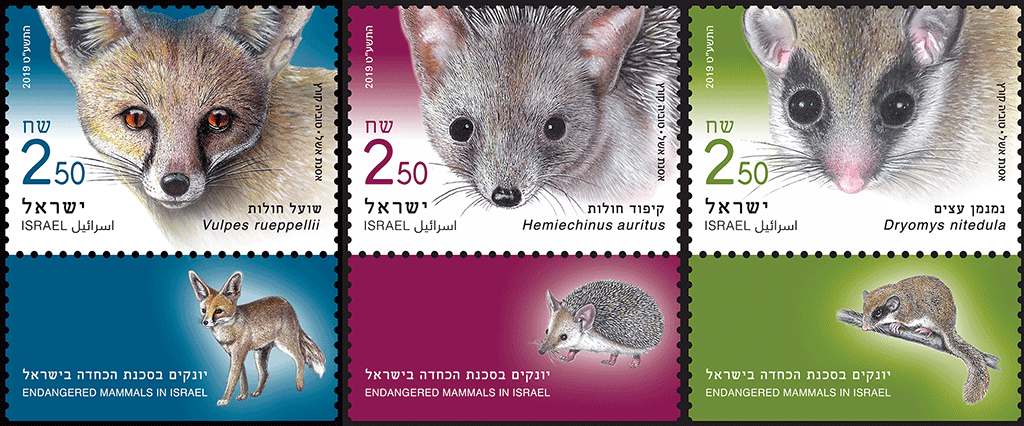 Three stamps: Vulpes rueppellii, Hemiechinus auritus, Dryomys nitedula
Three stamps: Vulpes rueppellii, Hemiechinus auritus, Dryomys nitedula
Date of Issue: 01 May 2019
Denominations: NIS 2.50,2.50,2.50
Size of Stamps: W: 40 mm H: 30 mm
Plate nos.: 1119
Designers: Tuvia Kurtz, Osnat Eshel
Printers: Cartor Security Printing, France
Printing method: Offset
Sheet type: Mini Special Sheet
No. of stamps in sheet: 9 (3 tabs)
Place of cancellation: Be’er Sheva
No. of FDCs: 1
Price of FDCs: NIS 8.70
From Israeli Post:
Three special mammal species in Israel have something in common – although each lives 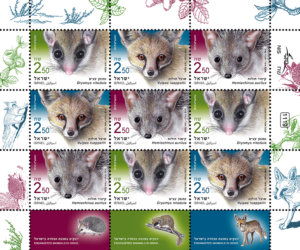 in a different area and habitat. All of these habitats are disappearing, be it loess covered areas, desert sands in the Negev or Mediterranean forests. The destruction of natural habitats is the most severe problem plaguing our world’s wildlife, and Israel is no exception.
in a different area and habitat. All of these habitats are disappearing, be it loess covered areas, desert sands in the Negev or Mediterranean forests. The destruction of natural habitats is the most severe problem plaguing our world’s wildlife, and Israel is no exception.
Wide open spaces that existed just 200 years ago have been populated. Fallow fields have become few and planted. The “wilderness” has been tamed by concrete and cement and crisscrossed by roads. All of these factors have contributed to the decrease and segmentation of natural habitats, making it difficult for wild animals in Israel to sustain their populations.
These three species are all nocturnal, thus they are seldom seen by humans, who may admire their beauty only for brief moments. They will cease to exist if we fail to make a 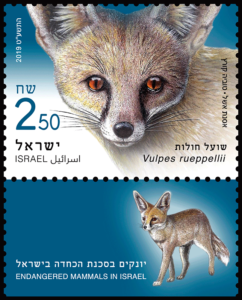 special effort to preserve them and their habitats.
special effort to preserve them and their habitats.
Rueppell’s Fox — Vulpes rueppellii
The Rueppell’s Fox is a small, beautiful species. It has a grey stripe running from the corner of its eye to its mouth and paws that are covered in fur as an adaptation to its sandy habitat. The Negev Desert is the northernmost distribution area of this species. In the 1980’s the population gradually disappeared from the sands of the Negev and Arava, due to the destruction from its displacement of its habitat by red foxes and wolves.
Forest Doormouse — Dryomys nitedula
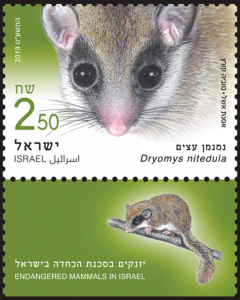 The Forest Doormouse is a small, stealth rodent that is active at night and few ever see it. It has a black “mask” on its face and a long, bushy tail. This species builds round nests in treetops, and spends its days sleeping there. At night it searches for acorns from oak trees and fruit in its
The Forest Doormouse is a small, stealth rodent that is active at night and few ever see it. It has a black “mask” on its face and a long, bushy tail. This species builds round nests in treetops, and spends its days sleeping there. At night it searches for acorns from oak trees and fruit in its
wooded Mediterranean habitat, using birds’ nests like tables. The Forest Doormouse may be found in the Galilee and was recently also seen in Jojoba groves in the northern Negev Desert. It is prevalent in the Balkans and southward to Israel, through Syria and Lebanon. Israel is the southernmost edge of its distribution.
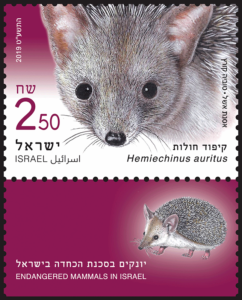 Long-eared Hedgehog — Hemiechinus auritus
Long-eared Hedgehog — Hemiechinus auritus
The Long-eared Hedgehog is the smallest hedgehog species in Israel. It has a light colored face, a pointed nose, large furless ears and no fur. It lives on the coastal plain as far as Caesarea in the north, in areas of loess sediment. There is an isolated population in the Golan Heights as well. The Long-eared Hedgehog may also be found in towns in the central of Israel, where it shares the urban habitat with Southern White-breasted Hedgehog.
—Keren Or
Zoologist, Zoological Center, Ramat Gan



